Political Science: Analytical Response Posts - Colonialism & Gender
VerifiedAdded on 2022/08/12
|14
|3500
|16
Homework Assignment
AI Summary
This assignment presents a student's analytical responses to three key topics: the impact of the British "Divide and Rule" policy on India, the concept of gender mainstreaming, and (though the specific details are cut off) likely a third related political science theme. The first response examines how the British exploited religious and community divisions, leading to the partition of India and Pakistan, ongoing communal tensions, and current governmental policies that further marginalize minority groups. It also briefly touches on the British contributions to women's rights. The second response defines gender mainstreaming as a policy approach to incorporate gender equality in all aspects of policy-making, discussing its origins, goals, and application. It highlights the importance of considering gender differences in resource access, power dynamics, and policy design. The response also provides examples of gender budgeting and its impact in various countries, emphasizing the need for proactive solutions to prevent gender-based discrimination. The analysis underscores the long-term nature of gender mainstreaming and the need for continued efforts to achieve true gender equality.
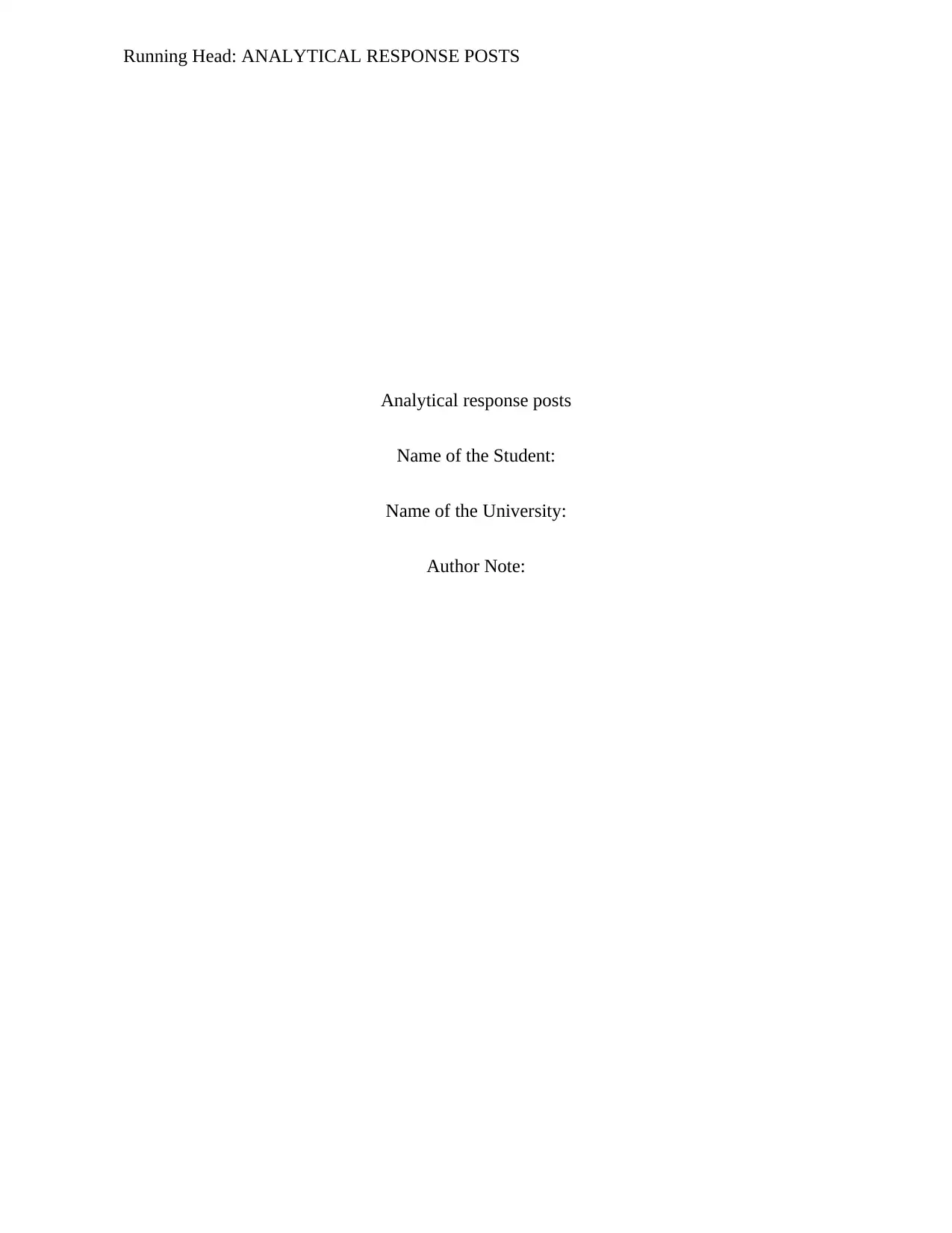
Running Head: ANALYTICAL RESPONSE POSTS
Analytical response posts
Name of the Student:
Name of the University:
Author Note:
Analytical response posts
Name of the Student:
Name of the University:
Author Note:
Paraphrase This Document
Need a fresh take? Get an instant paraphrase of this document with our AI Paraphraser

1ANALYTICAL RESPONSE POSTS
Table of Contents
Response to topic one......................................................................................................................2
Introduction..................................................................................................................................2
Discussion....................................................................................................................................2
Conclusion...................................................................................................................................4
Response to Topic 2.........................................................................................................................5
Introduction..................................................................................................................................5
Discussion....................................................................................................................................5
Conclusion...................................................................................................................................7
Response to topic 3......................................................................................................................8
Introduction..................................................................................................................................8
Discussion....................................................................................................................................8
Conclusion...................................................................................................................................9
Reference.......................................................................................................................................11
Table of Contents
Response to topic one......................................................................................................................2
Introduction..................................................................................................................................2
Discussion....................................................................................................................................2
Conclusion...................................................................................................................................4
Response to Topic 2.........................................................................................................................5
Introduction..................................................................................................................................5
Discussion....................................................................................................................................5
Conclusion...................................................................................................................................7
Response to topic 3......................................................................................................................8
Introduction..................................................................................................................................8
Discussion....................................................................................................................................8
Conclusion...................................................................................................................................9
Reference.......................................................................................................................................11
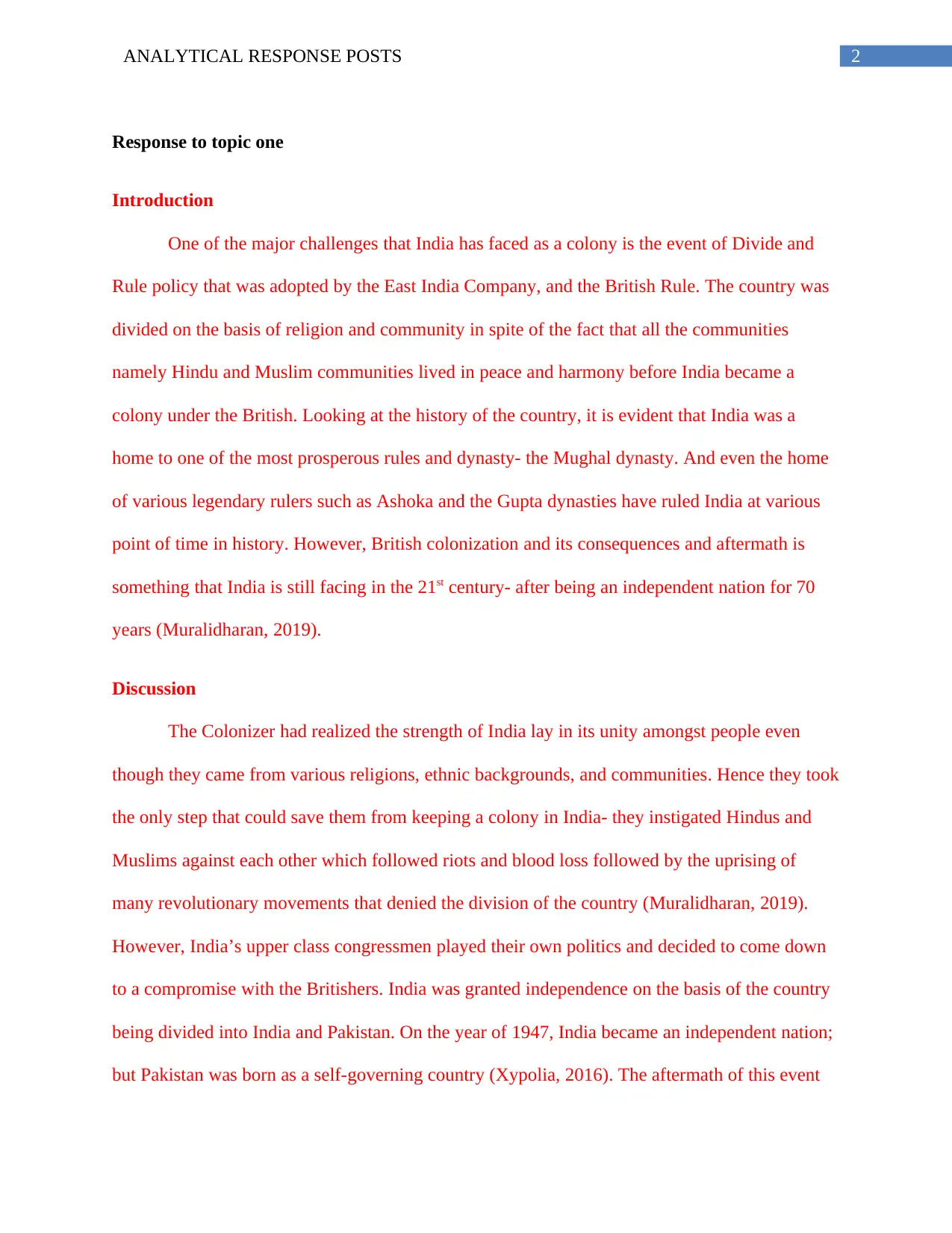
2ANALYTICAL RESPONSE POSTS
Response to topic one
Introduction
One of the major challenges that India has faced as a colony is the event of Divide and
Rule policy that was adopted by the East India Company, and the British Rule. The country was
divided on the basis of religion and community in spite of the fact that all the communities
namely Hindu and Muslim communities lived in peace and harmony before India became a
colony under the British. Looking at the history of the country, it is evident that India was a
home to one of the most prosperous rules and dynasty- the Mughal dynasty. And even the home
of various legendary rulers such as Ashoka and the Gupta dynasties have ruled India at various
point of time in history. However, British colonization and its consequences and aftermath is
something that India is still facing in the 21st century- after being an independent nation for 70
years (Muralidharan, 2019).
Discussion
The Colonizer had realized the strength of India lay in its unity amongst people even
though they came from various religions, ethnic backgrounds, and communities. Hence they took
the only step that could save them from keeping a colony in India- they instigated Hindus and
Muslims against each other which followed riots and blood loss followed by the uprising of
many revolutionary movements that denied the division of the country (Muralidharan, 2019).
However, India’s upper class congressmen played their own politics and decided to come down
to a compromise with the Britishers. India was granted independence on the basis of the country
being divided into India and Pakistan. On the year of 1947, India became an independent nation;
but Pakistan was born as a self-governing country (Xypolia, 2016). The aftermath of this event
Response to topic one
Introduction
One of the major challenges that India has faced as a colony is the event of Divide and
Rule policy that was adopted by the East India Company, and the British Rule. The country was
divided on the basis of religion and community in spite of the fact that all the communities
namely Hindu and Muslim communities lived in peace and harmony before India became a
colony under the British. Looking at the history of the country, it is evident that India was a
home to one of the most prosperous rules and dynasty- the Mughal dynasty. And even the home
of various legendary rulers such as Ashoka and the Gupta dynasties have ruled India at various
point of time in history. However, British colonization and its consequences and aftermath is
something that India is still facing in the 21st century- after being an independent nation for 70
years (Muralidharan, 2019).
Discussion
The Colonizer had realized the strength of India lay in its unity amongst people even
though they came from various religions, ethnic backgrounds, and communities. Hence they took
the only step that could save them from keeping a colony in India- they instigated Hindus and
Muslims against each other which followed riots and blood loss followed by the uprising of
many revolutionary movements that denied the division of the country (Muralidharan, 2019).
However, India’s upper class congressmen played their own politics and decided to come down
to a compromise with the Britishers. India was granted independence on the basis of the country
being divided into India and Pakistan. On the year of 1947, India became an independent nation;
but Pakistan was born as a self-governing country (Xypolia, 2016). The aftermath of this event
⊘ This is a preview!⊘
Do you want full access?
Subscribe today to unlock all pages.

Trusted by 1+ million students worldwide
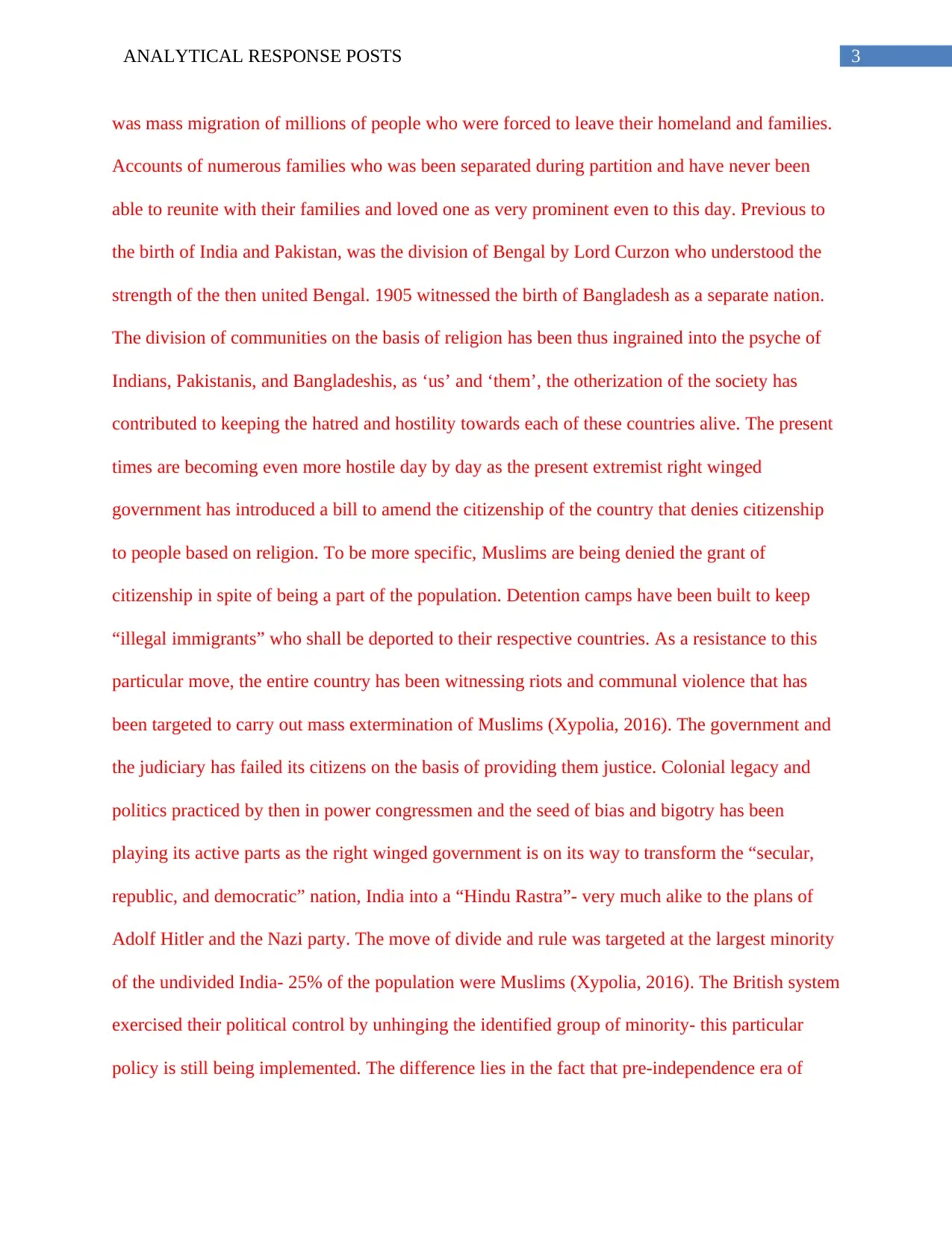
3ANALYTICAL RESPONSE POSTS
was mass migration of millions of people who were forced to leave their homeland and families.
Accounts of numerous families who was been separated during partition and have never been
able to reunite with their families and loved one as very prominent even to this day. Previous to
the birth of India and Pakistan, was the division of Bengal by Lord Curzon who understood the
strength of the then united Bengal. 1905 witnessed the birth of Bangladesh as a separate nation.
The division of communities on the basis of religion has been thus ingrained into the psyche of
Indians, Pakistanis, and Bangladeshis, as ‘us’ and ‘them’, the otherization of the society has
contributed to keeping the hatred and hostility towards each of these countries alive. The present
times are becoming even more hostile day by day as the present extremist right winged
government has introduced a bill to amend the citizenship of the country that denies citizenship
to people based on religion. To be more specific, Muslims are being denied the grant of
citizenship in spite of being a part of the population. Detention camps have been built to keep
“illegal immigrants” who shall be deported to their respective countries. As a resistance to this
particular move, the entire country has been witnessing riots and communal violence that has
been targeted to carry out mass extermination of Muslims (Xypolia, 2016). The government and
the judiciary has failed its citizens on the basis of providing them justice. Colonial legacy and
politics practiced by then in power congressmen and the seed of bias and bigotry has been
playing its active parts as the right winged government is on its way to transform the “secular,
republic, and democratic” nation, India into a “Hindu Rastra”- very much alike to the plans of
Adolf Hitler and the Nazi party. The move of divide and rule was targeted at the largest minority
of the undivided India- 25% of the population were Muslims (Xypolia, 2016). The British system
exercised their political control by unhinging the identified group of minority- this particular
policy is still being implemented. The difference lies in the fact that pre-independence era of
was mass migration of millions of people who were forced to leave their homeland and families.
Accounts of numerous families who was been separated during partition and have never been
able to reunite with their families and loved one as very prominent even to this day. Previous to
the birth of India and Pakistan, was the division of Bengal by Lord Curzon who understood the
strength of the then united Bengal. 1905 witnessed the birth of Bangladesh as a separate nation.
The division of communities on the basis of religion has been thus ingrained into the psyche of
Indians, Pakistanis, and Bangladeshis, as ‘us’ and ‘them’, the otherization of the society has
contributed to keeping the hatred and hostility towards each of these countries alive. The present
times are becoming even more hostile day by day as the present extremist right winged
government has introduced a bill to amend the citizenship of the country that denies citizenship
to people based on religion. To be more specific, Muslims are being denied the grant of
citizenship in spite of being a part of the population. Detention camps have been built to keep
“illegal immigrants” who shall be deported to their respective countries. As a resistance to this
particular move, the entire country has been witnessing riots and communal violence that has
been targeted to carry out mass extermination of Muslims (Xypolia, 2016). The government and
the judiciary has failed its citizens on the basis of providing them justice. Colonial legacy and
politics practiced by then in power congressmen and the seed of bias and bigotry has been
playing its active parts as the right winged government is on its way to transform the “secular,
republic, and democratic” nation, India into a “Hindu Rastra”- very much alike to the plans of
Adolf Hitler and the Nazi party. The move of divide and rule was targeted at the largest minority
of the undivided India- 25% of the population were Muslims (Xypolia, 2016). The British system
exercised their political control by unhinging the identified group of minority- this particular
policy is still being implemented. The difference lies in the fact that pre-independence era of
Paraphrase This Document
Need a fresh take? Get an instant paraphrase of this document with our AI Paraphraser
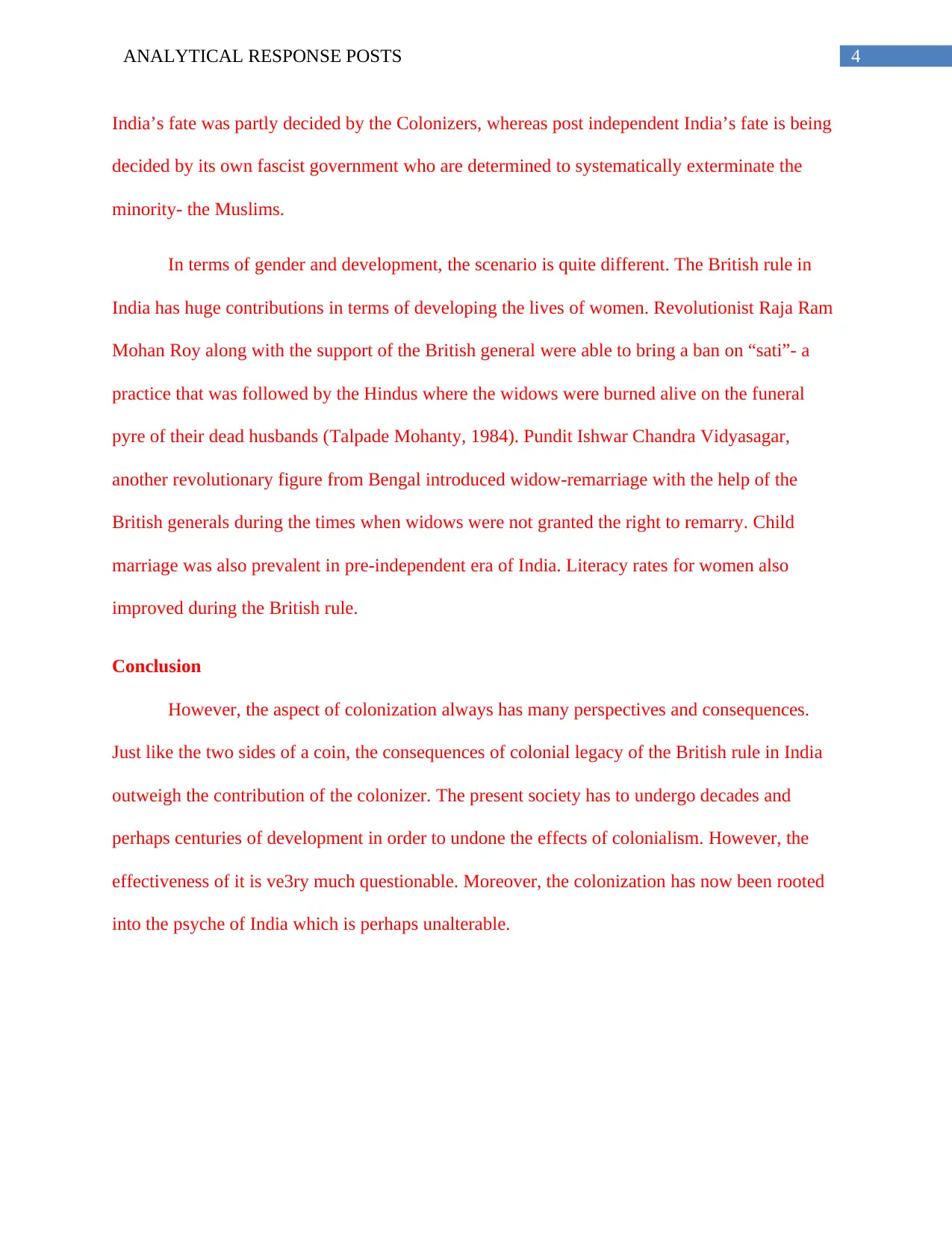
4ANALYTICAL RESPONSE POSTS
India’s fate was partly decided by the Colonizers, whereas post independent India’s fate is being
decided by its own fascist government who are determined to systematically exterminate the
minority- the Muslims.
In terms of gender and development, the scenario is quite different. The British rule in
India has huge contributions in terms of developing the lives of women. Revolutionist Raja Ram
Mohan Roy along with the support of the British general were able to bring a ban on “sati”- a
practice that was followed by the Hindus where the widows were burned alive on the funeral
pyre of their dead husbands (Talpade Mohanty, 1984). Pundit Ishwar Chandra Vidyasagar,
another revolutionary figure from Bengal introduced widow-remarriage with the help of the
British generals during the times when widows were not granted the right to remarry. Child
marriage was also prevalent in pre-independent era of India. Literacy rates for women also
improved during the British rule.
Conclusion
However, the aspect of colonization always has many perspectives and consequences.
Just like the two sides of a coin, the consequences of colonial legacy of the British rule in India
outweigh the contribution of the colonizer. The present society has to undergo decades and
perhaps centuries of development in order to undone the effects of colonialism. However, the
effectiveness of it is ve3ry much questionable. Moreover, the colonization has now been rooted
into the psyche of India which is perhaps unalterable.
India’s fate was partly decided by the Colonizers, whereas post independent India’s fate is being
decided by its own fascist government who are determined to systematically exterminate the
minority- the Muslims.
In terms of gender and development, the scenario is quite different. The British rule in
India has huge contributions in terms of developing the lives of women. Revolutionist Raja Ram
Mohan Roy along with the support of the British general were able to bring a ban on “sati”- a
practice that was followed by the Hindus where the widows were burned alive on the funeral
pyre of their dead husbands (Talpade Mohanty, 1984). Pundit Ishwar Chandra Vidyasagar,
another revolutionary figure from Bengal introduced widow-remarriage with the help of the
British generals during the times when widows were not granted the right to remarry. Child
marriage was also prevalent in pre-independent era of India. Literacy rates for women also
improved during the British rule.
Conclusion
However, the aspect of colonization always has many perspectives and consequences.
Just like the two sides of a coin, the consequences of colonial legacy of the British rule in India
outweigh the contribution of the colonizer. The present society has to undergo decades and
perhaps centuries of development in order to undone the effects of colonialism. However, the
effectiveness of it is ve3ry much questionable. Moreover, the colonization has now been rooted
into the psyche of India which is perhaps unalterable.
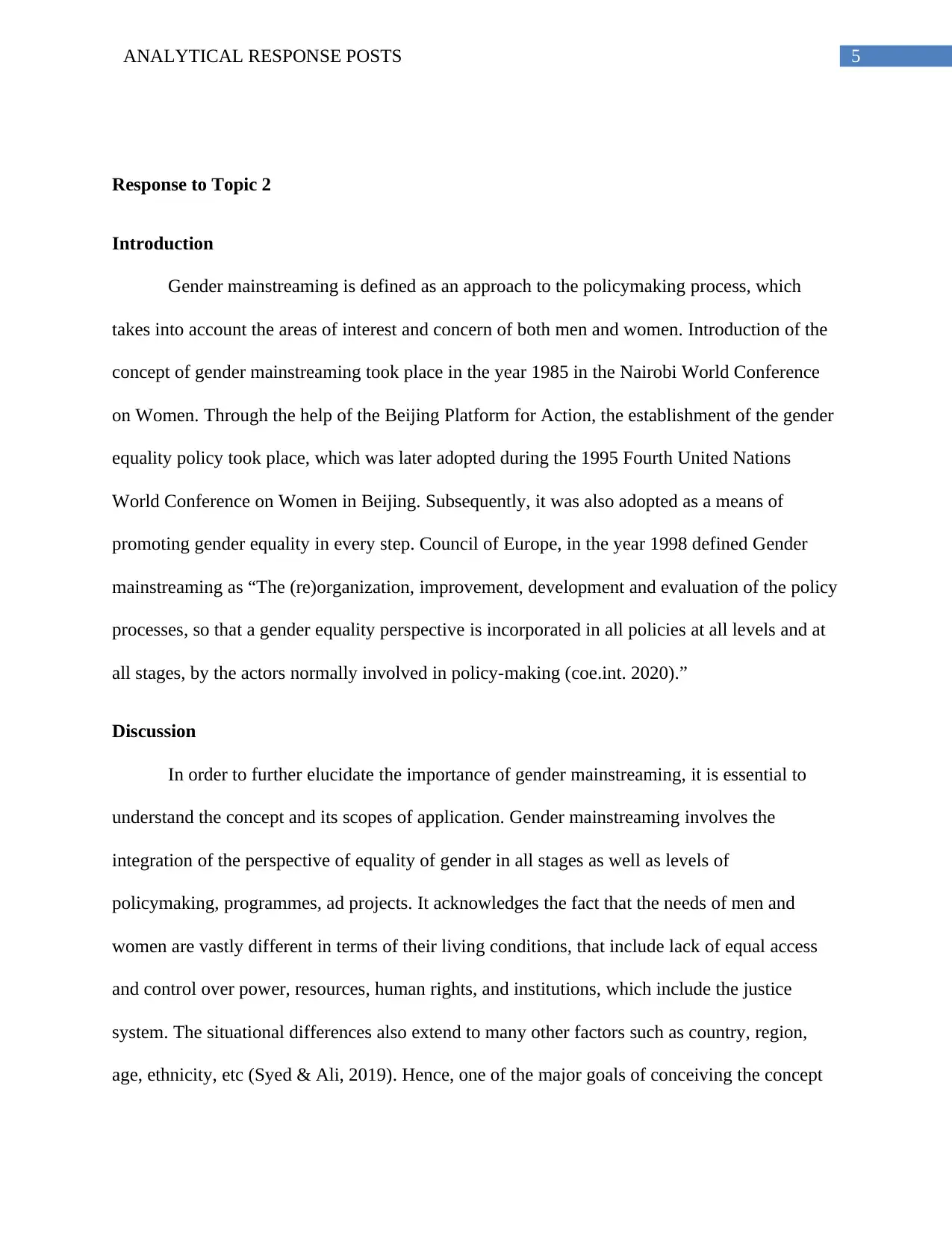
5ANALYTICAL RESPONSE POSTS
Response to Topic 2
Introduction
Gender mainstreaming is defined as an approach to the policymaking process, which
takes into account the areas of interest and concern of both men and women. Introduction of the
concept of gender mainstreaming took place in the year 1985 in the Nairobi World Conference
on Women. Through the help of the Beijing Platform for Action, the establishment of the gender
equality policy took place, which was later adopted during the 1995 Fourth United Nations
World Conference on Women in Beijing. Subsequently, it was also adopted as a means of
promoting gender equality in every step. Council of Europe, in the year 1998 defined Gender
mainstreaming as “The (re)organization, improvement, development and evaluation of the policy
processes, so that a gender equality perspective is incorporated in all policies at all levels and at
all stages, by the actors normally involved in policy-making (coe.int. 2020).”
Discussion
In order to further elucidate the importance of gender mainstreaming, it is essential to
understand the concept and its scopes of application. Gender mainstreaming involves the
integration of the perspective of equality of gender in all stages as well as levels of
policymaking, programmes, ad projects. It acknowledges the fact that the needs of men and
women are vastly different in terms of their living conditions, that include lack of equal access
and control over power, resources, human rights, and institutions, which include the justice
system. The situational differences also extend to many other factors such as country, region,
age, ethnicity, etc (Syed & Ali, 2019). Hence, one of the major goals of conceiving the concept
Response to Topic 2
Introduction
Gender mainstreaming is defined as an approach to the policymaking process, which
takes into account the areas of interest and concern of both men and women. Introduction of the
concept of gender mainstreaming took place in the year 1985 in the Nairobi World Conference
on Women. Through the help of the Beijing Platform for Action, the establishment of the gender
equality policy took place, which was later adopted during the 1995 Fourth United Nations
World Conference on Women in Beijing. Subsequently, it was also adopted as a means of
promoting gender equality in every step. Council of Europe, in the year 1998 defined Gender
mainstreaming as “The (re)organization, improvement, development and evaluation of the policy
processes, so that a gender equality perspective is incorporated in all policies at all levels and at
all stages, by the actors normally involved in policy-making (coe.int. 2020).”
Discussion
In order to further elucidate the importance of gender mainstreaming, it is essential to
understand the concept and its scopes of application. Gender mainstreaming involves the
integration of the perspective of equality of gender in all stages as well as levels of
policymaking, programmes, ad projects. It acknowledges the fact that the needs of men and
women are vastly different in terms of their living conditions, that include lack of equal access
and control over power, resources, human rights, and institutions, which include the justice
system. The situational differences also extend to many other factors such as country, region,
age, ethnicity, etc (Syed & Ali, 2019). Hence, one of the major goals of conceiving the concept
⊘ This is a preview!⊘
Do you want full access?
Subscribe today to unlock all pages.

Trusted by 1+ million students worldwide
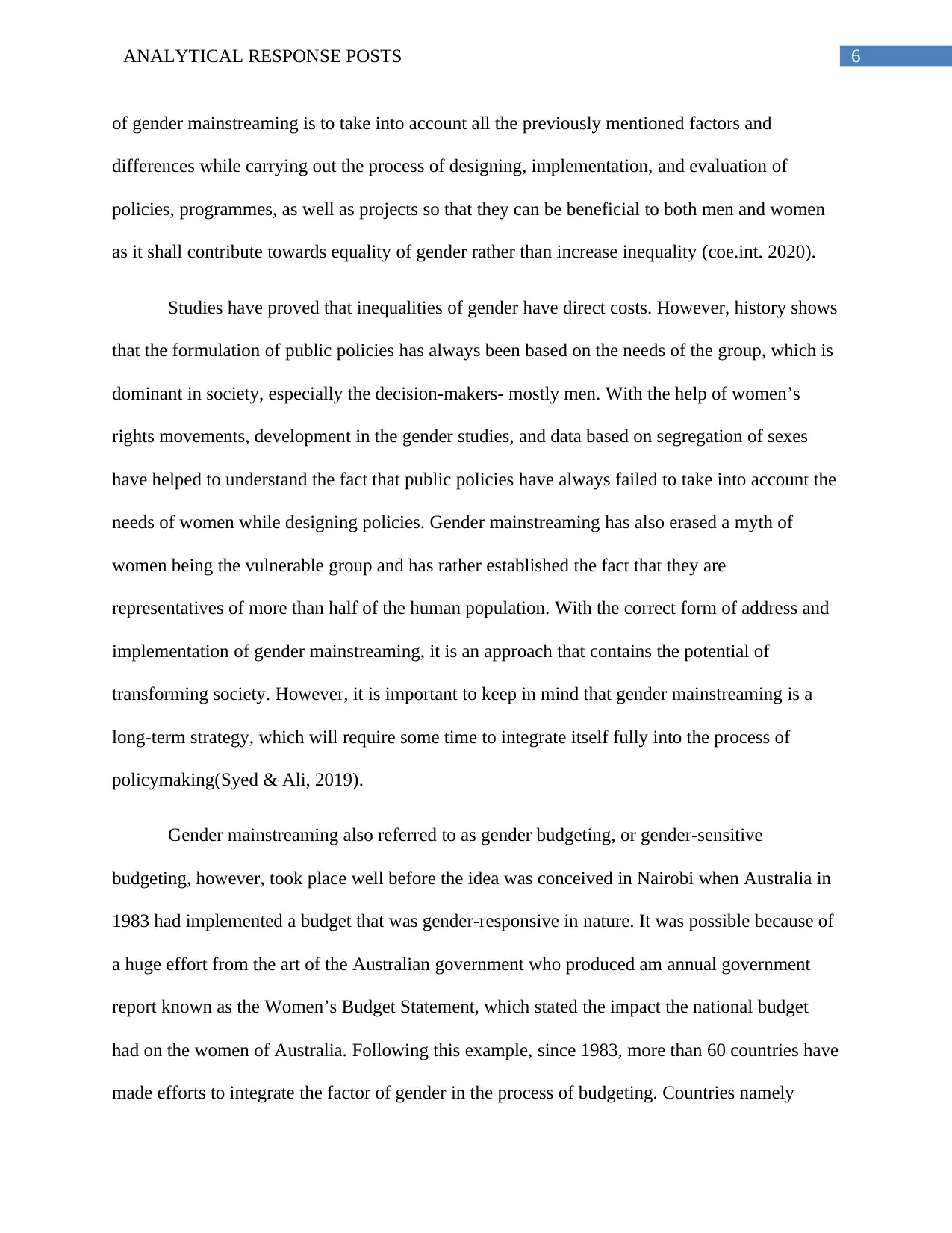
6ANALYTICAL RESPONSE POSTS
of gender mainstreaming is to take into account all the previously mentioned factors and
differences while carrying out the process of designing, implementation, and evaluation of
policies, programmes, as well as projects so that they can be beneficial to both men and women
as it shall contribute towards equality of gender rather than increase inequality (coe.int. 2020).
Studies have proved that inequalities of gender have direct costs. However, history shows
that the formulation of public policies has always been based on the needs of the group, which is
dominant in society, especially the decision-makers- mostly men. With the help of women’s
rights movements, development in the gender studies, and data based on segregation of sexes
have helped to understand the fact that public policies have always failed to take into account the
needs of women while designing policies. Gender mainstreaming has also erased a myth of
women being the vulnerable group and has rather established the fact that they are
representatives of more than half of the human population. With the correct form of address and
implementation of gender mainstreaming, it is an approach that contains the potential of
transforming society. However, it is important to keep in mind that gender mainstreaming is a
long-term strategy, which will require some time to integrate itself fully into the process of
policymaking(Syed & Ali, 2019).
Gender mainstreaming also referred to as gender budgeting, or gender-sensitive
budgeting, however, took place well before the idea was conceived in Nairobi when Australia in
1983 had implemented a budget that was gender-responsive in nature. It was possible because of
a huge effort from the art of the Australian government who produced am annual government
report known as the Women’s Budget Statement, which stated the impact the national budget
had on the women of Australia. Following this example, since 1983, more than 60 countries have
made efforts to integrate the factor of gender in the process of budgeting. Countries namely
of gender mainstreaming is to take into account all the previously mentioned factors and
differences while carrying out the process of designing, implementation, and evaluation of
policies, programmes, as well as projects so that they can be beneficial to both men and women
as it shall contribute towards equality of gender rather than increase inequality (coe.int. 2020).
Studies have proved that inequalities of gender have direct costs. However, history shows
that the formulation of public policies has always been based on the needs of the group, which is
dominant in society, especially the decision-makers- mostly men. With the help of women’s
rights movements, development in the gender studies, and data based on segregation of sexes
have helped to understand the fact that public policies have always failed to take into account the
needs of women while designing policies. Gender mainstreaming has also erased a myth of
women being the vulnerable group and has rather established the fact that they are
representatives of more than half of the human population. With the correct form of address and
implementation of gender mainstreaming, it is an approach that contains the potential of
transforming society. However, it is important to keep in mind that gender mainstreaming is a
long-term strategy, which will require some time to integrate itself fully into the process of
policymaking(Syed & Ali, 2019).
Gender mainstreaming also referred to as gender budgeting, or gender-sensitive
budgeting, however, took place well before the idea was conceived in Nairobi when Australia in
1983 had implemented a budget that was gender-responsive in nature. It was possible because of
a huge effort from the art of the Australian government who produced am annual government
report known as the Women’s Budget Statement, which stated the impact the national budget
had on the women of Australia. Following this example, since 1983, more than 60 countries have
made efforts to integrate the factor of gender in the process of budgeting. Countries namely
Paraphrase This Document
Need a fresh take? Get an instant paraphrase of this document with our AI Paraphraser
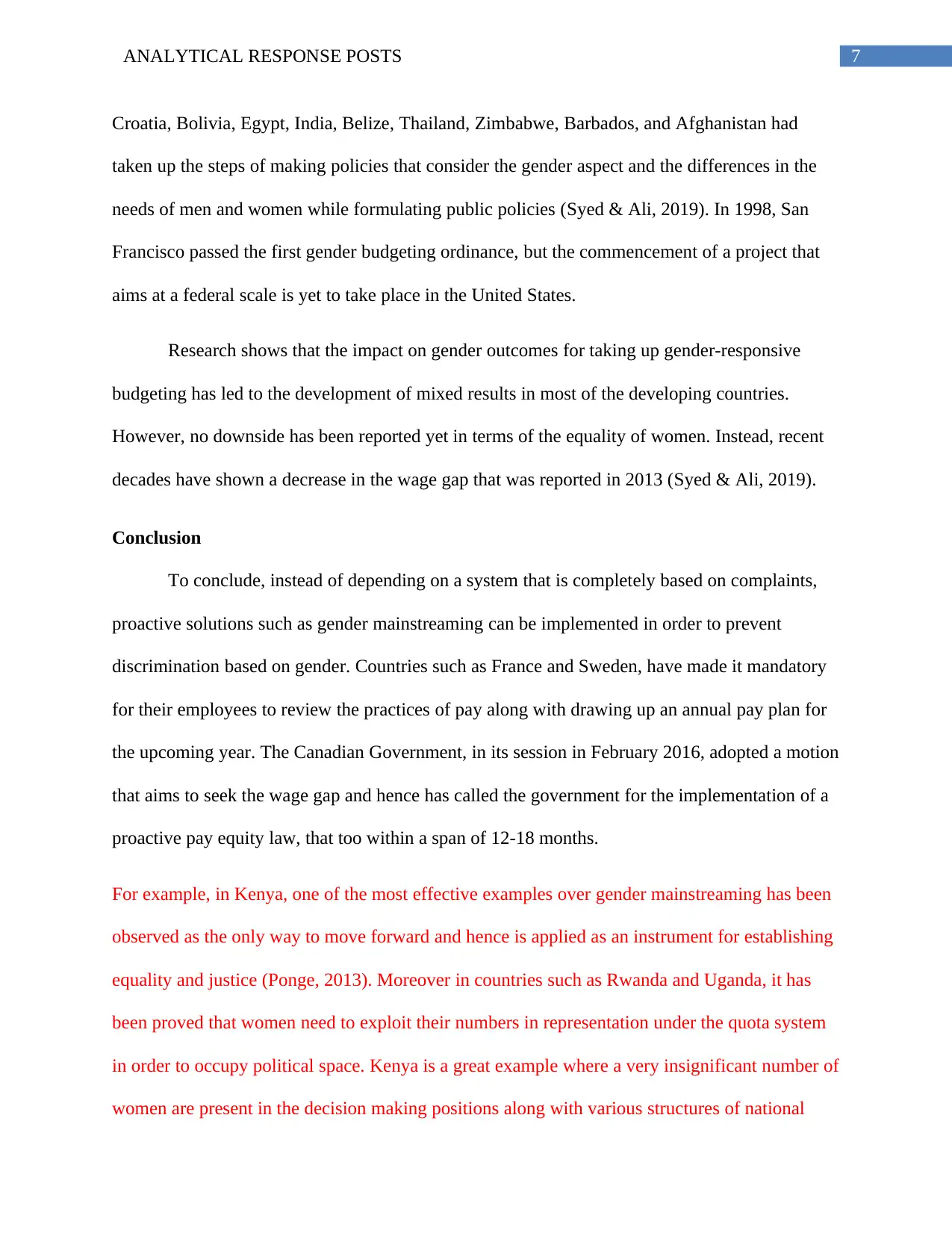
7ANALYTICAL RESPONSE POSTS
Croatia, Bolivia, Egypt, India, Belize, Thailand, Zimbabwe, Barbados, and Afghanistan had
taken up the steps of making policies that consider the gender aspect and the differences in the
needs of men and women while formulating public policies (Syed & Ali, 2019). In 1998, San
Francisco passed the first gender budgeting ordinance, but the commencement of a project that
aims at a federal scale is yet to take place in the United States.
Research shows that the impact on gender outcomes for taking up gender-responsive
budgeting has led to the development of mixed results in most of the developing countries.
However, no downside has been reported yet in terms of the equality of women. Instead, recent
decades have shown a decrease in the wage gap that was reported in 2013 (Syed & Ali, 2019).
Conclusion
To conclude, instead of depending on a system that is completely based on complaints,
proactive solutions such as gender mainstreaming can be implemented in order to prevent
discrimination based on gender. Countries such as France and Sweden, have made it mandatory
for their employees to review the practices of pay along with drawing up an annual pay plan for
the upcoming year. The Canadian Government, in its session in February 2016, adopted a motion
that aims to seek the wage gap and hence has called the government for the implementation of a
proactive pay equity law, that too within a span of 12-18 months.
For example, in Kenya, one of the most effective examples over gender mainstreaming has been
observed as the only way to move forward and hence is applied as an instrument for establishing
equality and justice (Ponge, 2013). Moreover in countries such as Rwanda and Uganda, it has
been proved that women need to exploit their numbers in representation under the quota system
in order to occupy political space. Kenya is a great example where a very insignificant number of
women are present in the decision making positions along with various structures of national
Croatia, Bolivia, Egypt, India, Belize, Thailand, Zimbabwe, Barbados, and Afghanistan had
taken up the steps of making policies that consider the gender aspect and the differences in the
needs of men and women while formulating public policies (Syed & Ali, 2019). In 1998, San
Francisco passed the first gender budgeting ordinance, but the commencement of a project that
aims at a federal scale is yet to take place in the United States.
Research shows that the impact on gender outcomes for taking up gender-responsive
budgeting has led to the development of mixed results in most of the developing countries.
However, no downside has been reported yet in terms of the equality of women. Instead, recent
decades have shown a decrease in the wage gap that was reported in 2013 (Syed & Ali, 2019).
Conclusion
To conclude, instead of depending on a system that is completely based on complaints,
proactive solutions such as gender mainstreaming can be implemented in order to prevent
discrimination based on gender. Countries such as France and Sweden, have made it mandatory
for their employees to review the practices of pay along with drawing up an annual pay plan for
the upcoming year. The Canadian Government, in its session in February 2016, adopted a motion
that aims to seek the wage gap and hence has called the government for the implementation of a
proactive pay equity law, that too within a span of 12-18 months.
For example, in Kenya, one of the most effective examples over gender mainstreaming has been
observed as the only way to move forward and hence is applied as an instrument for establishing
equality and justice (Ponge, 2013). Moreover in countries such as Rwanda and Uganda, it has
been proved that women need to exploit their numbers in representation under the quota system
in order to occupy political space. Kenya is a great example where a very insignificant number of
women are present in the decision making positions along with various structures of national
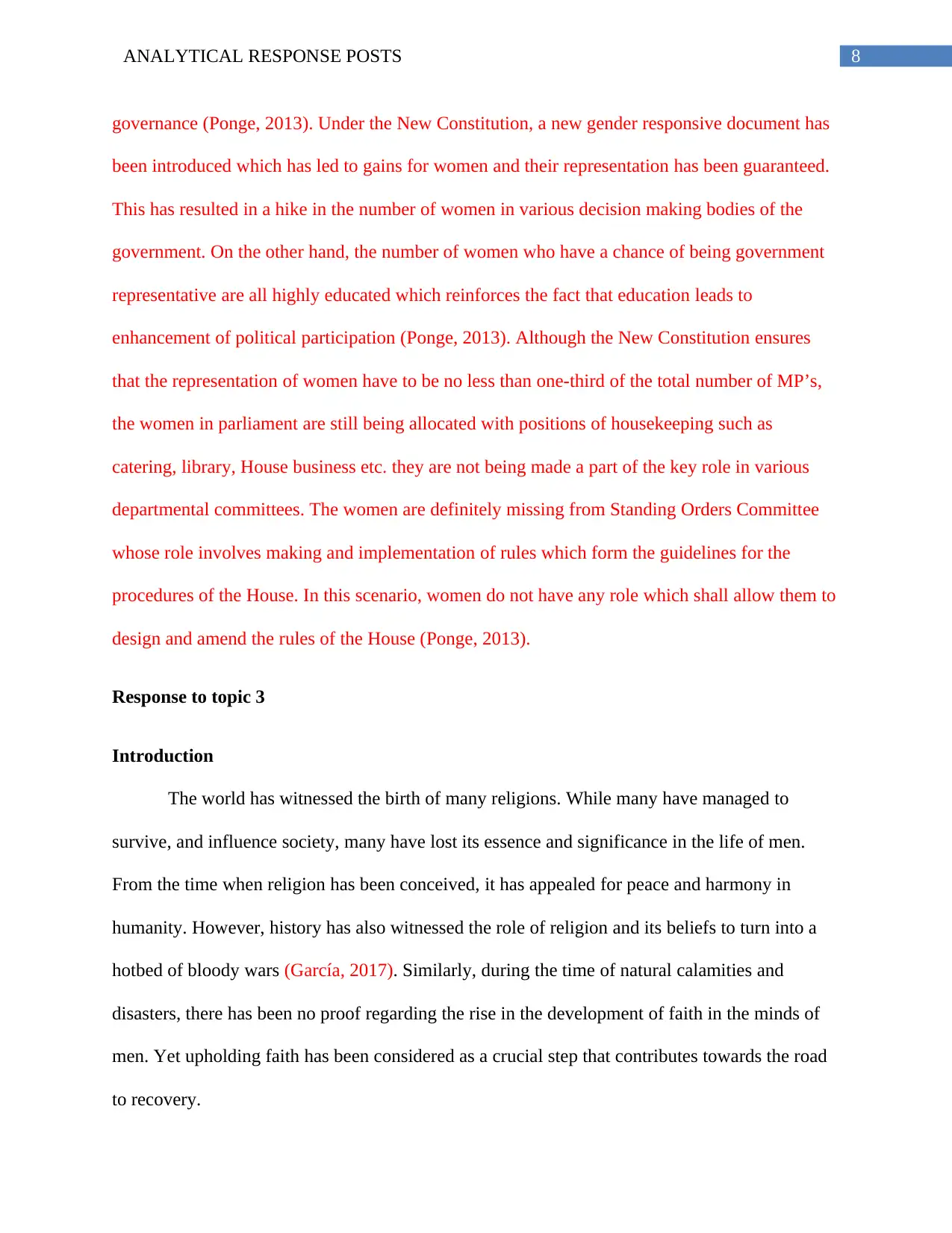
8ANALYTICAL RESPONSE POSTS
governance (Ponge, 2013). Under the New Constitution, a new gender responsive document has
been introduced which has led to gains for women and their representation has been guaranteed.
This has resulted in a hike in the number of women in various decision making bodies of the
government. On the other hand, the number of women who have a chance of being government
representative are all highly educated which reinforces the fact that education leads to
enhancement of political participation (Ponge, 2013). Although the New Constitution ensures
that the representation of women have to be no less than one-third of the total number of MP’s,
the women in parliament are still being allocated with positions of housekeeping such as
catering, library, House business etc. they are not being made a part of the key role in various
departmental committees. The women are definitely missing from Standing Orders Committee
whose role involves making and implementation of rules which form the guidelines for the
procedures of the House. In this scenario, women do not have any role which shall allow them to
design and amend the rules of the House (Ponge, 2013).
Response to topic 3
Introduction
The world has witnessed the birth of many religions. While many have managed to
survive, and influence society, many have lost its essence and significance in the life of men.
From the time when religion has been conceived, it has appealed for peace and harmony in
humanity. However, history has also witnessed the role of religion and its beliefs to turn into a
hotbed of bloody wars (García, 2017). Similarly, during the time of natural calamities and
disasters, there has been no proof regarding the rise in the development of faith in the minds of
men. Yet upholding faith has been considered as a crucial step that contributes towards the road
to recovery.
governance (Ponge, 2013). Under the New Constitution, a new gender responsive document has
been introduced which has led to gains for women and their representation has been guaranteed.
This has resulted in a hike in the number of women in various decision making bodies of the
government. On the other hand, the number of women who have a chance of being government
representative are all highly educated which reinforces the fact that education leads to
enhancement of political participation (Ponge, 2013). Although the New Constitution ensures
that the representation of women have to be no less than one-third of the total number of MP’s,
the women in parliament are still being allocated with positions of housekeeping such as
catering, library, House business etc. they are not being made a part of the key role in various
departmental committees. The women are definitely missing from Standing Orders Committee
whose role involves making and implementation of rules which form the guidelines for the
procedures of the House. In this scenario, women do not have any role which shall allow them to
design and amend the rules of the House (Ponge, 2013).
Response to topic 3
Introduction
The world has witnessed the birth of many religions. While many have managed to
survive, and influence society, many have lost its essence and significance in the life of men.
From the time when religion has been conceived, it has appealed for peace and harmony in
humanity. However, history has also witnessed the role of religion and its beliefs to turn into a
hotbed of bloody wars (García, 2017). Similarly, during the time of natural calamities and
disasters, there has been no proof regarding the rise in the development of faith in the minds of
men. Yet upholding faith has been considered as a crucial step that contributes towards the road
to recovery.
⊘ This is a preview!⊘
Do you want full access?
Subscribe today to unlock all pages.

Trusted by 1+ million students worldwide
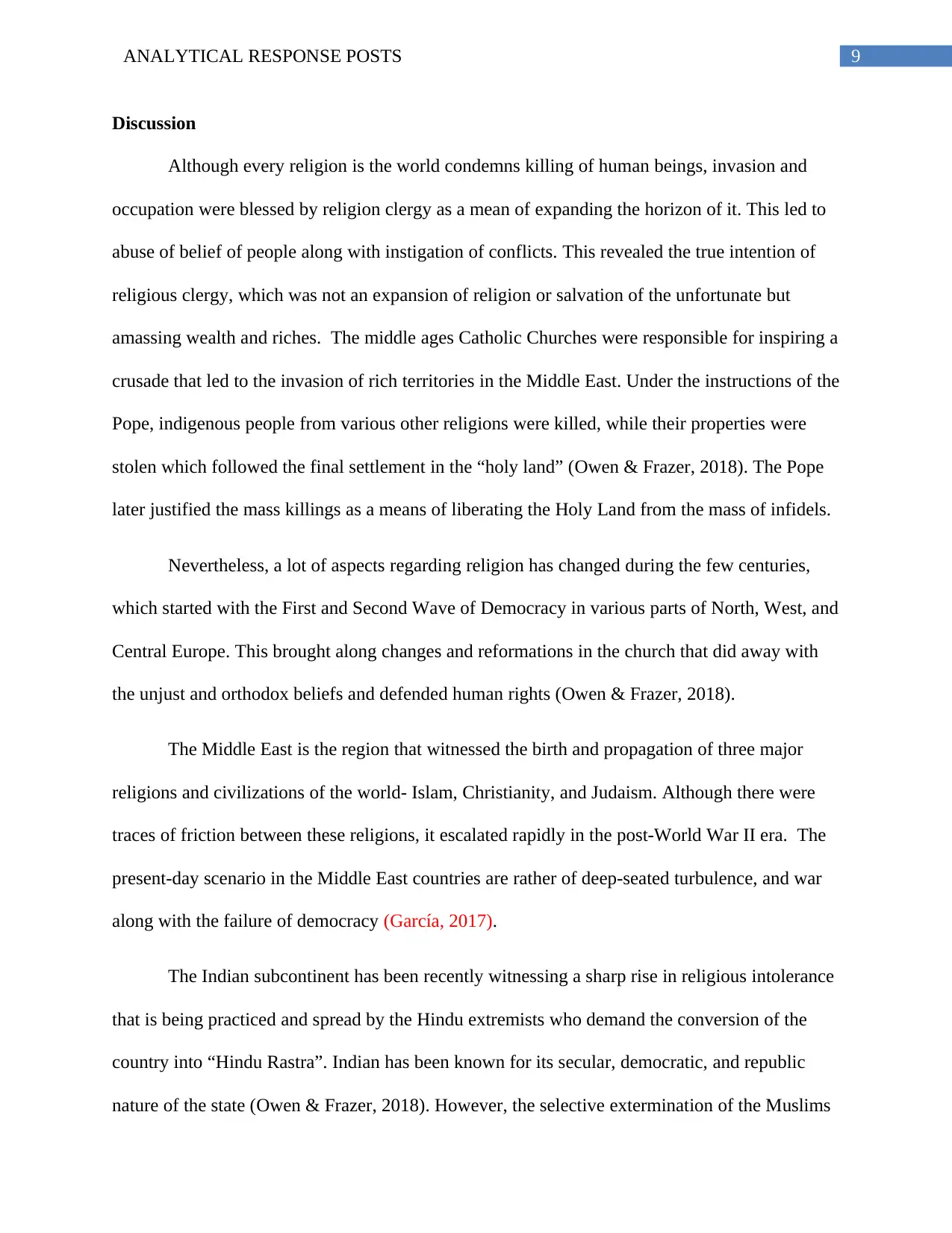
9ANALYTICAL RESPONSE POSTS
Discussion
Although every religion is the world condemns killing of human beings, invasion and
occupation were blessed by religion clergy as a mean of expanding the horizon of it. This led to
abuse of belief of people along with instigation of conflicts. This revealed the true intention of
religious clergy, which was not an expansion of religion or salvation of the unfortunate but
amassing wealth and riches. The middle ages Catholic Churches were responsible for inspiring a
crusade that led to the invasion of rich territories in the Middle East. Under the instructions of the
Pope, indigenous people from various other religions were killed, while their properties were
stolen which followed the final settlement in the “holy land” (Owen & Frazer, 2018). The Pope
later justified the mass killings as a means of liberating the Holy Land from the mass of infidels.
Nevertheless, a lot of aspects regarding religion has changed during the few centuries,
which started with the First and Second Wave of Democracy in various parts of North, West, and
Central Europe. This brought along changes and reformations in the church that did away with
the unjust and orthodox beliefs and defended human rights (Owen & Frazer, 2018).
The Middle East is the region that witnessed the birth and propagation of three major
religions and civilizations of the world- Islam, Christianity, and Judaism. Although there were
traces of friction between these religions, it escalated rapidly in the post-World War II era. The
present-day scenario in the Middle East countries are rather of deep-seated turbulence, and war
along with the failure of democracy (García, 2017).
The Indian subcontinent has been recently witnessing a sharp rise in religious intolerance
that is being practiced and spread by the Hindu extremists who demand the conversion of the
country into “Hindu Rastra”. Indian has been known for its secular, democratic, and republic
nature of the state (Owen & Frazer, 2018). However, the selective extermination of the Muslims
Discussion
Although every religion is the world condemns killing of human beings, invasion and
occupation were blessed by religion clergy as a mean of expanding the horizon of it. This led to
abuse of belief of people along with instigation of conflicts. This revealed the true intention of
religious clergy, which was not an expansion of religion or salvation of the unfortunate but
amassing wealth and riches. The middle ages Catholic Churches were responsible for inspiring a
crusade that led to the invasion of rich territories in the Middle East. Under the instructions of the
Pope, indigenous people from various other religions were killed, while their properties were
stolen which followed the final settlement in the “holy land” (Owen & Frazer, 2018). The Pope
later justified the mass killings as a means of liberating the Holy Land from the mass of infidels.
Nevertheless, a lot of aspects regarding religion has changed during the few centuries,
which started with the First and Second Wave of Democracy in various parts of North, West, and
Central Europe. This brought along changes and reformations in the church that did away with
the unjust and orthodox beliefs and defended human rights (Owen & Frazer, 2018).
The Middle East is the region that witnessed the birth and propagation of three major
religions and civilizations of the world- Islam, Christianity, and Judaism. Although there were
traces of friction between these religions, it escalated rapidly in the post-World War II era. The
present-day scenario in the Middle East countries are rather of deep-seated turbulence, and war
along with the failure of democracy (García, 2017).
The Indian subcontinent has been recently witnessing a sharp rise in religious intolerance
that is being practiced and spread by the Hindu extremists who demand the conversion of the
country into “Hindu Rastra”. Indian has been known for its secular, democratic, and republic
nature of the state (Owen & Frazer, 2018). However, the selective extermination of the Muslims
Paraphrase This Document
Need a fresh take? Get an instant paraphrase of this document with our AI Paraphraser
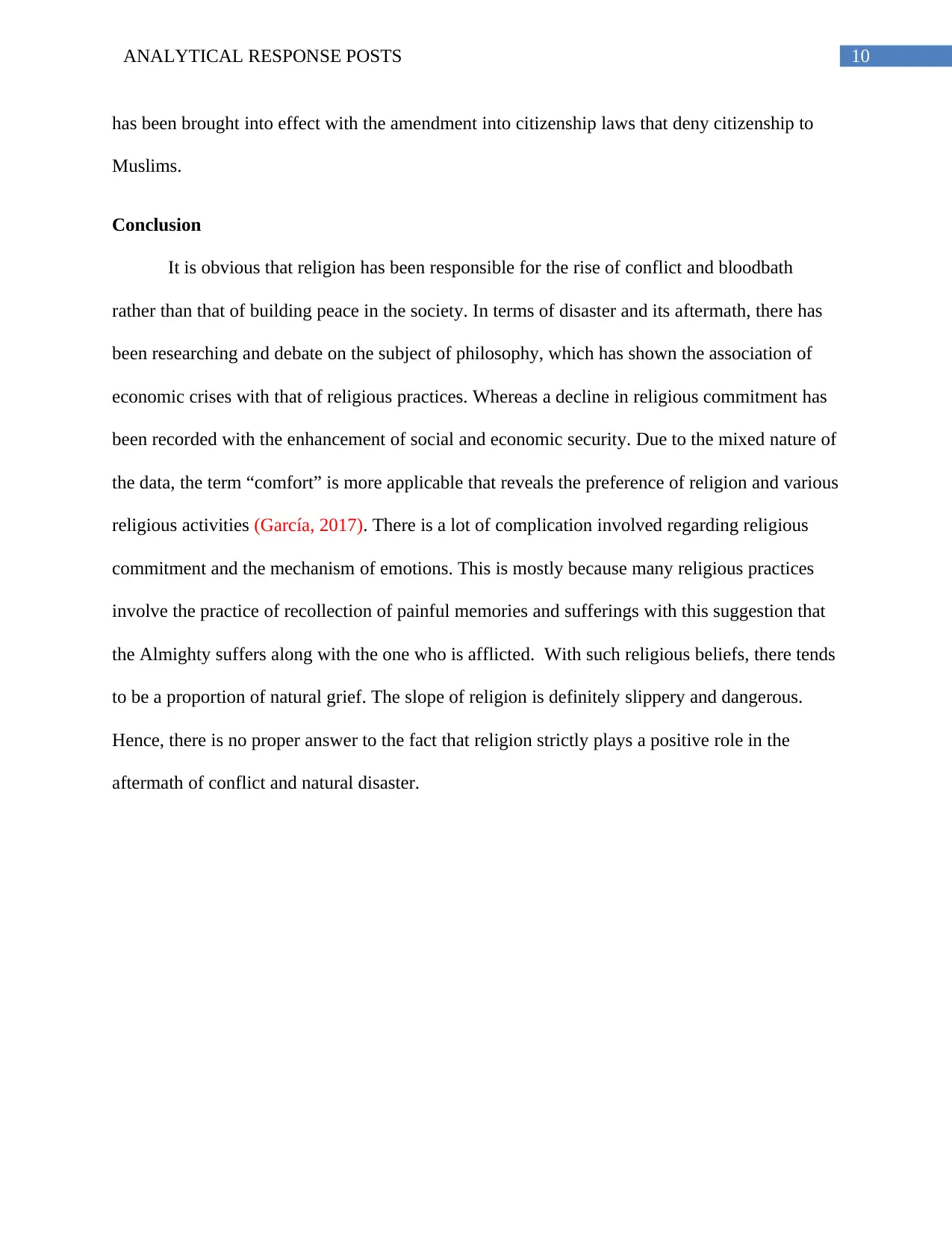
10ANALYTICAL RESPONSE POSTS
has been brought into effect with the amendment into citizenship laws that deny citizenship to
Muslims.
Conclusion
It is obvious that religion has been responsible for the rise of conflict and bloodbath
rather than that of building peace in the society. In terms of disaster and its aftermath, there has
been researching and debate on the subject of philosophy, which has shown the association of
economic crises with that of religious practices. Whereas a decline in religious commitment has
been recorded with the enhancement of social and economic security. Due to the mixed nature of
the data, the term “comfort” is more applicable that reveals the preference of religion and various
religious activities (García, 2017). There is a lot of complication involved regarding religious
commitment and the mechanism of emotions. This is mostly because many religious practices
involve the practice of recollection of painful memories and sufferings with this suggestion that
the Almighty suffers along with the one who is afflicted. With such religious beliefs, there tends
to be a proportion of natural grief. The slope of religion is definitely slippery and dangerous.
Hence, there is no proper answer to the fact that religion strictly plays a positive role in the
aftermath of conflict and natural disaster.
has been brought into effect with the amendment into citizenship laws that deny citizenship to
Muslims.
Conclusion
It is obvious that religion has been responsible for the rise of conflict and bloodbath
rather than that of building peace in the society. In terms of disaster and its aftermath, there has
been researching and debate on the subject of philosophy, which has shown the association of
economic crises with that of religious practices. Whereas a decline in religious commitment has
been recorded with the enhancement of social and economic security. Due to the mixed nature of
the data, the term “comfort” is more applicable that reveals the preference of religion and various
religious activities (García, 2017). There is a lot of complication involved regarding religious
commitment and the mechanism of emotions. This is mostly because many religious practices
involve the practice of recollection of painful memories and sufferings with this suggestion that
the Almighty suffers along with the one who is afflicted. With such religious beliefs, there tends
to be a proportion of natural grief. The slope of religion is definitely slippery and dangerous.
Hence, there is no proper answer to the fact that religion strictly plays a positive role in the
aftermath of conflict and natural disaster.
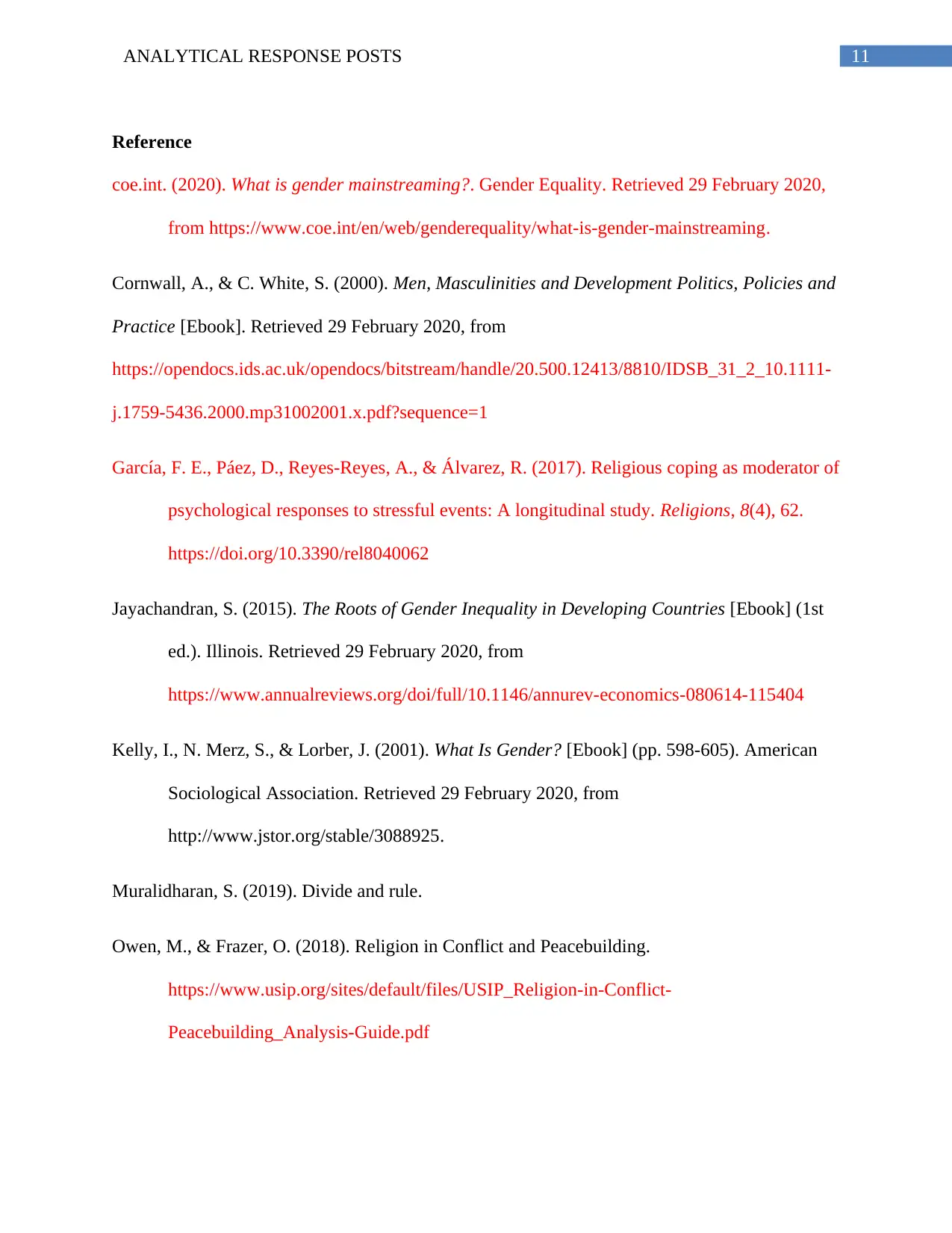
11ANALYTICAL RESPONSE POSTS
Reference
coe.int. (2020). What is gender mainstreaming?. Gender Equality. Retrieved 29 February 2020,
from https://www.coe.int/en/web/genderequality/what-is-gender-mainstreaming.
Cornwall, A., & C. White, S. (2000). Men, Masculinities and Development Politics, Policies and
Practice [Ebook]. Retrieved 29 February 2020, from
https://opendocs.ids.ac.uk/opendocs/bitstream/handle/20.500.12413/8810/IDSB_31_2_10.1111-
j.1759-5436.2000.mp31002001.x.pdf?sequence=1
García, F. E., Páez, D., Reyes-Reyes, A., & Álvarez, R. (2017). Religious coping as moderator of
psychological responses to stressful events: A longitudinal study. Religions, 8(4), 62.
https://doi.org/10.3390/rel8040062
Jayachandran, S. (2015). The Roots of Gender Inequality in Developing Countries [Ebook] (1st
ed.). Illinois. Retrieved 29 February 2020, from
https://www.annualreviews.org/doi/full/10.1146/annurev-economics-080614-115404
Kelly, I., N. Merz, S., & Lorber, J. (2001). What Is Gender? [Ebook] (pp. 598-605). American
Sociological Association. Retrieved 29 February 2020, from
http://www.jstor.org/stable/3088925.
Muralidharan, S. (2019). Divide and rule.
Owen, M., & Frazer, O. (2018). Religion in Conflict and Peacebuilding.
https://www.usip.org/sites/default/files/USIP_Religion-in-Conflict-
Peacebuilding_Analysis-Guide.pdf
Reference
coe.int. (2020). What is gender mainstreaming?. Gender Equality. Retrieved 29 February 2020,
from https://www.coe.int/en/web/genderequality/what-is-gender-mainstreaming.
Cornwall, A., & C. White, S. (2000). Men, Masculinities and Development Politics, Policies and
Practice [Ebook]. Retrieved 29 February 2020, from
https://opendocs.ids.ac.uk/opendocs/bitstream/handle/20.500.12413/8810/IDSB_31_2_10.1111-
j.1759-5436.2000.mp31002001.x.pdf?sequence=1
García, F. E., Páez, D., Reyes-Reyes, A., & Álvarez, R. (2017). Religious coping as moderator of
psychological responses to stressful events: A longitudinal study. Religions, 8(4), 62.
https://doi.org/10.3390/rel8040062
Jayachandran, S. (2015). The Roots of Gender Inequality in Developing Countries [Ebook] (1st
ed.). Illinois. Retrieved 29 February 2020, from
https://www.annualreviews.org/doi/full/10.1146/annurev-economics-080614-115404
Kelly, I., N. Merz, S., & Lorber, J. (2001). What Is Gender? [Ebook] (pp. 598-605). American
Sociological Association. Retrieved 29 February 2020, from
http://www.jstor.org/stable/3088925.
Muralidharan, S. (2019). Divide and rule.
Owen, M., & Frazer, O. (2018). Religion in Conflict and Peacebuilding.
https://www.usip.org/sites/default/files/USIP_Religion-in-Conflict-
Peacebuilding_Analysis-Guide.pdf
⊘ This is a preview!⊘
Do you want full access?
Subscribe today to unlock all pages.

Trusted by 1+ million students worldwide
1 out of 14
Your All-in-One AI-Powered Toolkit for Academic Success.
+13062052269
info@desklib.com
Available 24*7 on WhatsApp / Email
![[object Object]](/_next/static/media/star-bottom.7253800d.svg)
Unlock your academic potential
Copyright © 2020–2025 A2Z Services. All Rights Reserved. Developed and managed by ZUCOL.